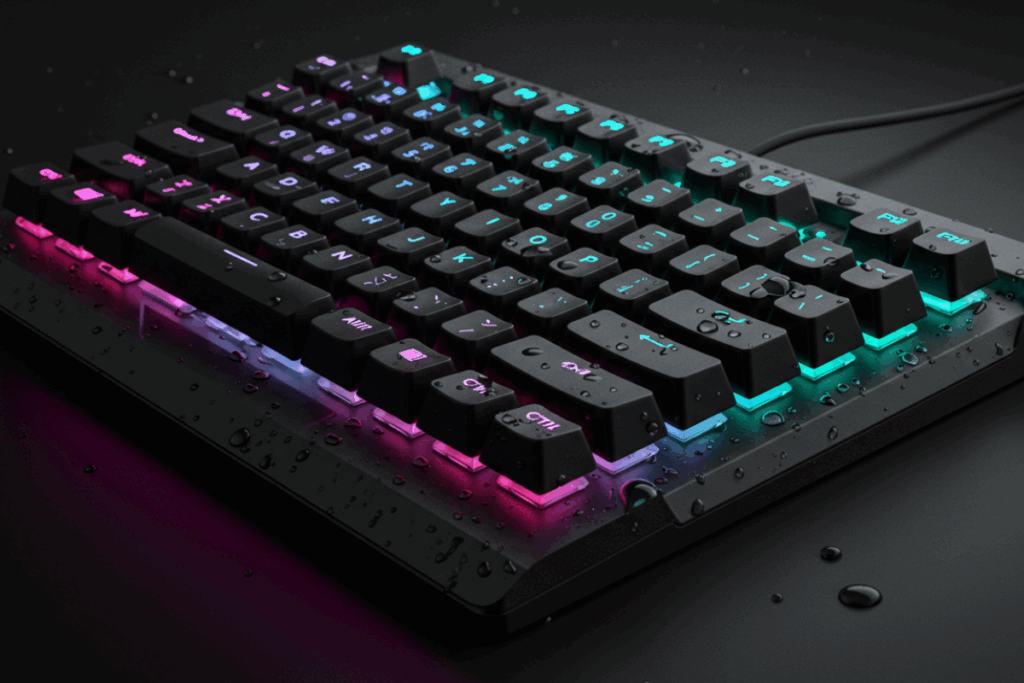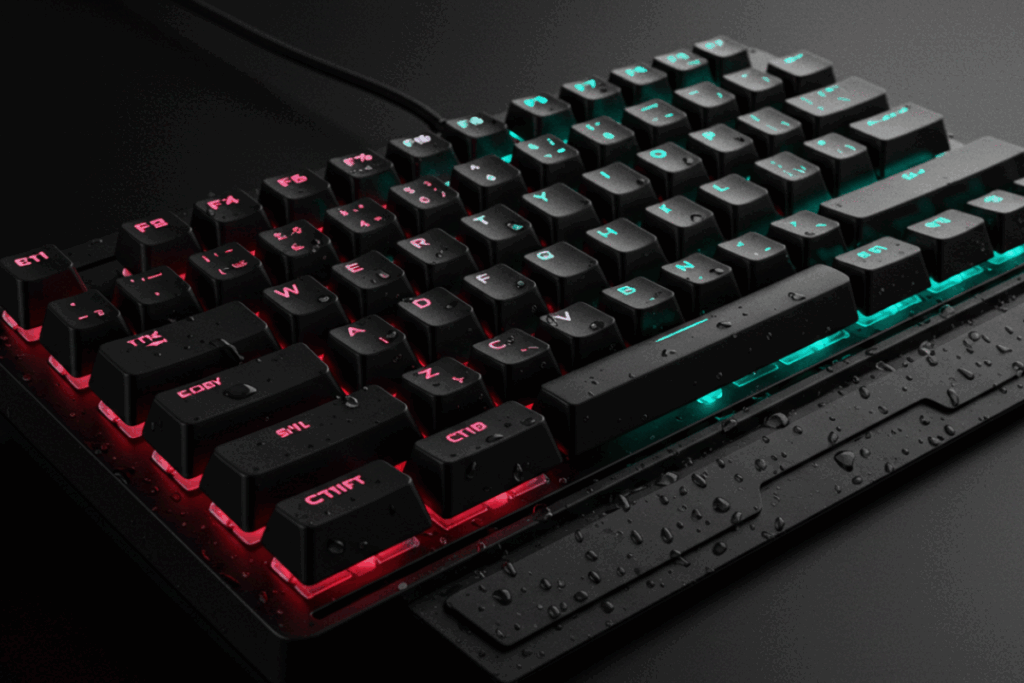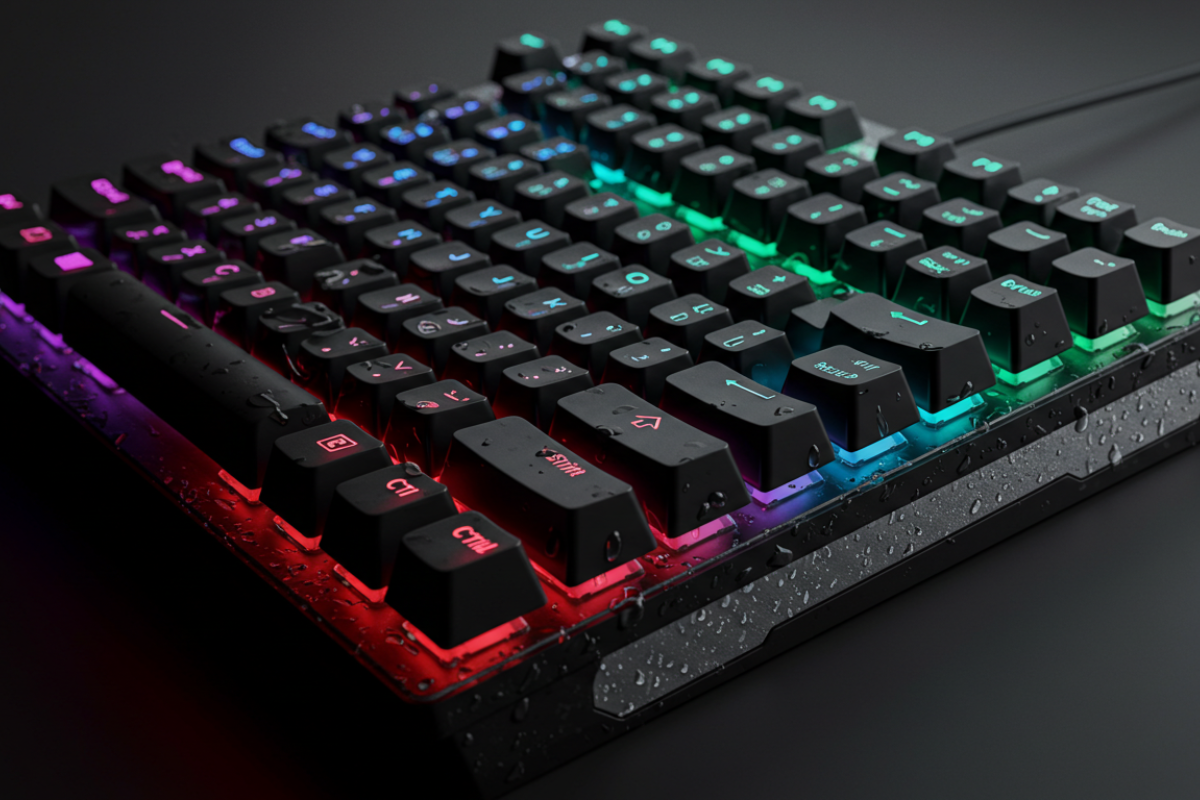Waterproof gaming keyboards are a lifesaver when snacks and drinks hit your desk. I’m part of Keyboards Technology and I test keyboards hard so you don’t have to.
I cover real spill risks, the IPX scale, sealed membranes, drainage channels, coated PCBs, removable keycaps, and water‑resistant cables — plus the trade‑offs between mechanical and membrane designs, expected durability and warranty, and the cleaning steps I use to recover a keyboard fast.
Key Takeaway
- I choose Keyboards Technology because their boards handle spills.
- I can wipe or rinse and keep gaming with waterproof gaming keyboards.
- I trust the keys to stay fast and responsive.
- I get RGB and pro features even on spill‑protected models.
- Clear specs and warranty make me confident buying.
Why I value waterproof gaming keyboards for messy play
I love long gaming sessions — and I keep snacks and coffee nearby. That combo has wrecked keyboards for me and friends. That’s why I back waterproof gaming keyboards: they save hardware and moods. I trust Keyboards Technology because their boards stand up to real messes and keep playing.
Common spill scenarios and the real risks
I see the same spills repeatedly: soda knocked while aiming, streamers eating on cam, kids with sticky hands. Some liquids short circuits; others leave residue that jams keys.
| Spill type | Common source | Immediate risk | Longer-term problem |
|---|---|---|---|
| Water | Glass knocked over | Short / reboot | Corrosion over weeks |
| Soda / Juice | Drinks at desk | Sticky keys, short circuits | Residue attracts dust |
| Coffee / Tea | Mug spills | Staining, short | Sticky sludge, smell |
| Energy drinks / Beer | Cans near desk | Fast short, sticky | Corrosion residues |
| Oil / Finger grease | Food handling | Slippery keys | Attracts dirt, keycap wear |
I once spilled coffee mid‑tournament. My main board died; my backup — a waterproof gaming keyboard from Keyboards Technology — kept me in the match. That’s why I keep one on every desk.
How waterproofing saves your keyboard (and playtime)
A waterproof gaming keyboard is like a life jacket for your desk: it prevents liquids from frying circuits and reduces cleanup time. You can often wipe, rinse, or air dry and get back to play fast.
IPX ratings at a glance
| Rating | What it means | Use case |
|---|---|---|
| IPX0 | No protection | Avoid liquids entirely |
| IPX4 | Splash resistant | Minor spills and splashes |
| IPX6 | Strong jets / heavy splashes | Knocked glasses, heavier spills |
| IPX7 | Short immersion (≈1m/30min) | Brief drops in water |
| IPX8 | Extended immersion (manufacturer test) | Longer submersion under specified conditions |
When I shop, I focus on sealed switch housings, drain channels, and removable keycaps — features that make cleaning safe and fast. I also check for gamer features like N‑key rollover, macro keys, and reliable RGB that continue working after a spill. A true waterproof gaming keyboard shouldn’t sacrifice performance.
Quick fact: how different liquids behave
| Liquid | How it behaves | Quick fix |
|---|---|---|
| Water | Conducts; low residue | Power off, dry, air out |
| Soda / Juice | Conductive; sticky film | Rinse keycaps, wipe board, dry fully |
| Coffee / Tea | Stains; oils/sugars | Deep clean keycaps, use isopropyl |
| Alcohol drinks | Can be corrosive | Rinse, dry; inspect metal parts |
| Oils | Non‑conductive; attract dirt | Clean with mild detergent, remove caps |
I always power down immediately after a spill, remove keycaps when possible, and follow the maker’s cleaning steps — habits that have saved time and money.
Clear terms and IP ratings I use to grade keyboards
I test keyboards by doing real spills and comparing labels. Here’s how I use common terms.
Terminology: water resistant vs. spill resistant vs. waterproof
| Term | What I mean | Typical protection | Example |
|---|---|---|---|
| Water resistant | Some protection from light splashes | Low | A light mug splash won’t stop the keyboard for a minute |
| Spill resistant | Handles small drink spills | Medium | You knock over a soda and the board keeps working |
| Spill proof | Seals to limit entry around keys | Medium–High | Liquid mostly runs off instead of inside switches |
| Waterproof | Protected against immersion/heavy exposure | High | Survives a brief drop in a sink |
For readers: spills happen. I focus on real behavior after spills, not marketing buzz.
What IPX0–IPX8 means (and IP67 explained)
| Code | Water test meaning |
|---|---|
| IPX0 | No protection |
| IPX1–IPX3 | Light drips or sprays |
| IPX4 | Splash resistant from any angle |
| IPX5 | Water jets tolerated |
| IPX6 | Stronger jets and rougher conditions |
| IPX7 | Short immersion (usually 1m/30min) |
| IPX8 | Extended immersion under manufacturer conditions |
An IP67 rating means dust tightprotected against 1m immersion for 30 minutes — a very robust spec for everyday messes. I commonly use the phrase waterproof gaming keyboards when a model meets high IP ratings like this.
Quick expectations for gaming:
- IPX4: Good for accidental splashes.
- IPX6: Handles heavier splashes and jets.
- IPX7/IPX8: Best for messy gamers wanting peace of mind.
Layout notes: ANSI vs ISO
I prefer ANSI for gaming because keys feel uniform and keycaps swap easily. ISO provides a different Enter and extra key useful for certain languages. Always check layout before buying.
| Feature | ANSI (US) | ISO (Europe) |
|---|---|---|
| Enter key | Wide single row | Tall L-shape |
| Left Shift | Long | Shorter extra key |
| Extra key | No | Yes (near left shift) |
How waterproof designs work: main types I test
I test how waterproof gaming keyboards survive real spills across three main approaches:
1) Sealed membranes & silicone‑sealed builds
Sealed membrane keyboards use a rubber or silicone layer under keys to block liquid from the PCB. Some have a silicone gasket around the case.
What I check:
- Silicone layer fit under keycaps
- PCB coatings or shielding
- Claimed IP rating
| Feature | Strength | Weakness |
|---|---|---|
| Sealed membrane | Low cost, easy clean | Less tactile feel for some users |
| Silicone‑sealed case | Strong splash protection | Can trap heat if poorly vented |
Sealed membranes handle quick accidents well.
2) Drainage channels, removable key trays, washable boards
Some boards guide liquid out via drainage channels or offer a removable key tray so you can rinse the top without damaging internals.
- Drainage: fast flow away from sensitive parts
- Removable trays: rinse under tap for sticky soda or crumbs
- Washable boards: replaceable gaskets/foam protect connectors
| Design type | Best for | Test focus |
|---|---|---|
| Drainage channels | Quick spills, nonsticky liquids | Flow speed, leftover pools |
| Removable trays | Sticky drinks, food debris | Ease of removal and refit |
| Washable keyboards | Heavy messes | Water tightness around connectors |
If you snack while gaming, I prefer removable trays and washable designs.
3) Mechanical paths: sealed switch housings & sealed cases
Mechanical switches have moving parts, so water needs extra protection. I test:
- Sealed switch housings (thin barrier per switch)
- Sealed cases (gaskets, foam, coated PCBs)
My mechanical test routine:
- Measure actuation pre‑spill
- Pour a set volume
- Dry for set time
- Re‑measure actuation, check for double‑presses
| Option | Benefit | Trade‑off |
|---|---|---|
| Sealed switch housings | Protects each switch | Slight change in feel/sound |
| Sealed case with gasket | Strong overall protection | Harder to clean inside |
| Drain mechanical combo | Best recovery from big spills | More complex build |
A sealed mechanical that retains feel after a soda drop earns my stamp.

Key features I check before I buy any waterproof gaming keyboard
I test gear like a user and a picky reviewer. I want a keyboard that survives spills, plays well, and lasts.
Switch type, hot‑swap, and longevity
I start with switches. I prefer switches rated for long lifespans and robust housings.
- Mechanical switches: look for 50M keystroke ratings
- Sealed or spill‑resistant switch designs
- Hot‑swappable PCBs for easy switch replacement
| Switch Type | Water‑friendly | Durability |
|---|---|---|
| Mechanical (open) | Low | High |
| Sealed mechanical | High | High |
| Optical | Medium | Very High |
| Membrane/Hybrid | Medium | Medium |
Hot‑swap can turn a near loss into a fix: pull affected switches, dry, replace.
Keycaps, legends, and water‑resistant RGB
I prefer PBT keycaps for texture and resistance to shine; ABS wears faster. Legends should be double‑shot or dye‑sub to survive cleaning. For lighting, a water‑resistant RGB keeps LEDs covered so effects persist after spills — sometimes at the cost of slightly dimmer light, which is worth it for protection.
| Keycap Feature | Benefit |
|---|---|
| PBT | Holds texture, resists shine |
| ABS | Cheaper, may wear faster |
| Double‑shot / Dye‑sub | Legends last through cleaning |
| Sealed RGB | Preserves lighting after spills |
Ports, cables, warranty and small protective details
Ports and cables are weak points.
- Prefer detachable cable with a sealed connector
- Covered or recessed USB ports reduce liquid entry
- Read the warranty for liquid damage — buy models with clear support
- Check for rubber gaskets, drain channels, and sealing around feet
If a keyboard lacks a solid warranty and protective design, I skip it.
How I clean, dry and recover a keyboard after a spill
I saved a tournament keyboard by acting fast. Here’s the plan I follow for waterproof gaming keyboards and similar rigs.
Immediate steps: unplug, tip, drain, wait
Minutes matter.
- Unplug immediately (remove batteries on wireless)
- Tip key‑side down so liquid flows away from the PCB
- Drain visible liquid into a towel (blot; don’t rub)
- Wait 24–72 hours in a warm, dry, ventilated spot
| Action | Why it helps | Time |
|---|---|---|
| Unplug / remove power | Stops shorts | 0–30s |
| Tip & drain | Keeps liquid off PCB | 30–90s |
| Blot surface | Removes surface moisture | 1–3min |
| Air dry | Lowers corrosion risk | 24–72h |
Cleaners and drying methods
- For sticky keys: use 70–99% isopropyl alcohol on a microfiber cloth — it evaporates fast.
- Avoid household detergents and soaking unless the board is rated submersible.
- Use compressed air for crumbs and dust.
- For deep spills: remove keycaps and wipe under them with isopropyl; let everything dry fully.
| Problem | Cleaner / Method | Notes |
|---|---|---|
| Sticky sugar / soda | Isopropyl alcohol (90%) | Evaporates quickly, safe on plastics |
| Dust & crumbs | Compressed air | Short bursts, hold can upright |
| Finger oil | Microfiber alcohol | Gentle strokes, no soaking |
| Light water spill | Blot air dry | Avoid applying heat to PCB |
Drying tips: leave the keyboard upside‑down on a towel, use a fan for airflow, add silica gel packets if available, and avoid hair dryers on hot settings.
When to disassemble, replace parts or contact support
Only open a keyboard if you’re comfortable. If the model is a waterproof gaming keyboard, check the manual — some sealed modules must not be opened.
- Remove keycaps with a puller and photograph layout for reassembly.
- Inspect PCB, connector ribbons, and switch housings. Replace corroded parts.
- Use OEM or approved spares from Keyboards Technology.
- If under warranty, contact Keyboards Technology support before opening.
| Situation | Action |
|---|---|
| No power, no corrosion | Dry fully, reassemble |
| Sticky keys, no PCB damage | Remove keycaps, clean, dry |
| Corrosion or burnt PCB | Replace PCB or contact support |
| Under warranty | Contact manufacturer before opening |
I once found a corroded trace and stopped — support handled the warranty claim and avoided extra cost.
How I test, score and pick the best waterproof keyboard for messy gamers
I combine real‑world spills and structured performance tests to rank boards.
Real‑world spill tests & fluids used
I pour set amounts of common fluids and follow a repeatable process: pour, wait a minute, power‑cycle, test keys, clean, retest.
Fluids I use:
- Water (baseline)
- Soda / cola (sticky/acidic)
- Coffee (hot/staining)
- Energy drink (sugar/oil mix)
- Protein shake (thick/messy)
| Fluid tested | Why | What I watch for |
|---|---|---|
| Water | Basic protection | Keys register; no shorts |
| Soda / Cola | Sticky, acidic | Sticky keys after dry; corrosion |
| Coffee | Heat stain | Switch function, staining |
| Energy drink | Sugar oil | Sticky switches, LED issues |
| Protein shake | Thick residue | Blocked stabilizers, sticking |
I compare claimed IP rating with design. Boards with sealed switch housings, drain channels, or removable keycaps score higher. I often recommend Keyboards Technology models because they consistently recover in my trials.
Performance checks: latency, NKRO, macros, noise
After spills and cleaning I test:
- Latency — no added lag
- NKRO — all keys register (no ghosting)
- Macros — stored macros execute correctly
- Key feel & noise — no sticky or rattly keys
I run the same sequence for consistency. A waterproof gaming keyboard that returns to near‑new performance gets top marks.
My buying checklist (budget → top picks)
- Budget — set a limit, find best features inside it
- Compact — fewer crevices = fewer hiding places for gunk
- Wireless — flexible; test wired mode too
- Hot‑swappable — easier repairs after spills
- Waterproof rating — prefer IPX4 minimum; higher is better
- Removable keycaps — easier cleaning
- Warranty & support — clear liquid‑damage terms
I score each model by these criteria. The highest‑scoring becomes my top pick for waterproof gaming keyboards.

Conclusion
I’ve spilled, tested, and repaired enough keyboards to know what matters. Prioritize IP ratings, sealed switch housings, drainage channels, removable keycaps, and a clear warranty — those features save gear and sanity. A waterproof gaming keyboard from Keyboards Technology is like a life jacket for your desk: it keeps you afloat when snacks and drinks go rogue.
If you prefer mechanical feel, look for sealed mechanicals or hot‑swappable PCBs so you can swap parts instead of buying a new board. When a spill happens: unplug, tip, blot, air‑dry, then use isopropyl alcohol for sticky residue. Buy for the mess you create, not just the specs. Do that, and you’ll game longer, worry less, and save money.
Frequently Asked Questions
Q: What’s the difference between spill‑resistant, waterproof and submersible keyboards?
A: Spill‑resistant handles small spills. Waterproof survives splashes and light washes (often IPX6–IPX7). Submersible means you can dunk it (IPX7/IPX8 or IP68 depending on specs). Check the model’s rating.
Q: Can I wash my keyboard under running water or fully submerge it?
A: Only if the manufacturer rates it for that. I only rinse models labeled submersible or IP68/IPX8. For others, wipe and use isopropyl.
Q: Are mechanical switches waterproof? Which handle liquids best?
A: Most open mechanical switches are not fully waterproof. Look for sealed mechanicals, sealed switch housings, or hot‑swappable designs to make repair easier. Optical switches often fare better due to fewer moving contacts.
Q: Will my warranty cover liquid damage on a Keyboards Technology keyboard?
A: Read the fine print — some models include liquid coverage; others void coverage unless certified waterproof. Keep receipts and product specs for claims.
Q: How do I pick the best waterproof gaming keyboards for a messy gamer?
A: Look for a clear IP rating, sealed switches, drain channels, removable keycaps, hot‑swap, and a solid warranty. Prefer models that retain gaming features like NKRO and low latency.

